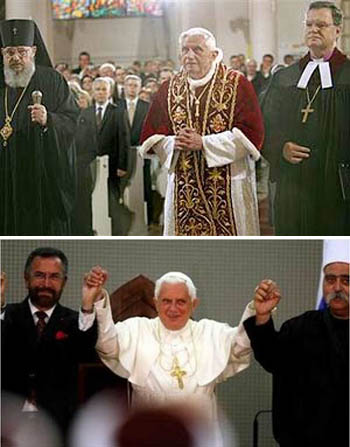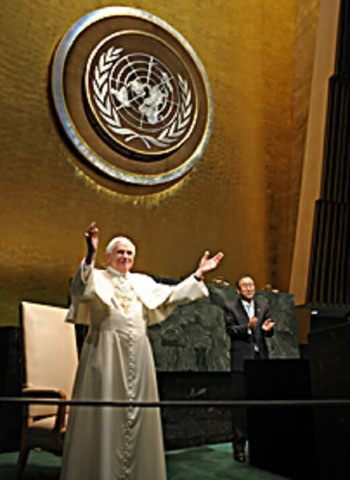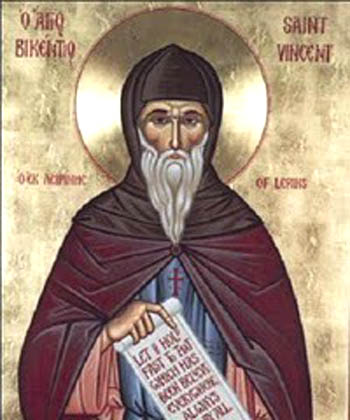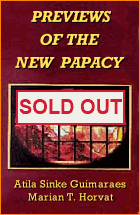Consequences of Vatican II
 |
 |
 |
 |
 |
 |
 |
The Oath against Modernism vs.
the ‘Hermeneutic of Continuity’
The expression “hermeneutic of continuity” came into vogue with the ascension of Pope Benedict XVI.
On December 22, 2005, in his speech to the Roman Curia, Pope Benedict XVI laid out what would be the program of his pontificate. Usually a Pope will do this in his first encyclical, but informed commentators at the time observed that Pope Benedict appeared to lay out the program for his pontificate in this December 22 address, and not his first encyclical.
In this speech, it is clear that the pivotal principle that would be the program for his pontificate is the Second Vatican Council. (1)
 However, says the Pope, there has been a problem with the Council. Too many in the Church, he laments, approach the Council through a “hermeneutic of rupture” and a “hermeneutic of discontinuity” with the past. Thus, Pope Benedict says, many Catholics have approached the Council with an interpretation of rupture with the past.
However, says the Pope, there has been a problem with the Council. Too many in the Church, he laments, approach the Council through a “hermeneutic of rupture” and a “hermeneutic of discontinuity” with the past. Thus, Pope Benedict says, many Catholics have approached the Council with an interpretation of rupture with the past.
The proper way to approach the Council, he insists, is through a “hermeneutic of continuity.” His basic claim — and this has always been his claim as Cardinal Ratzinger — is that Vatican II did not constitute a rupture with Tradition, but a legitimate development of it. We can find this legitimate development if we approach the Council through a hermeneutic — an interpretation — of continuity.
This gives the impression to many that Pope Benedict XVI plans a restoration of Tradition in the Church.
But this is not the case. Yes, Pope Benedict issued the Motu Proprio freeing the Tridentine Mass. This was a matter of justice for which he deserves credit, and it is something we could have guessed he would do, even based on his statements as Cardinal Ratzinger.
But the hermeneutic of continuity does not signal a return to Tradition. Rather, it is another attempt, first and foremost, I believe, to save Vatican II.
Vatican II is still his pivotal principle. The so-called “hermeneutic of continuity” approach will give us nothing more than a new synthesis between Tradition and Vatican II — a synthesis between Tradition and Modernism — which is not a legitimate synthesis.
Novel approach
Initially I want to focus on just one aspect that tells us from the beginning that the “hermeneutic of continuity” approach does not signal a true restoration of Tradition. This is the term itself. Pope Benedict does not employ the Traditional terminology for the preservation of Tradition, but has effectively invented a new expression: “hermeneutic of continuity”.
This is because his approach to Tradition is at odds with what the Church taught for 2000 years.
For example, Benedict XVI never says that the answer to the crisis in the Church is to return the admonition of Pope Agatho who said, “Nothing of the things appointed ought to be diminished; nothing changed; nothing added; but they must be preserved both as regards expression and meaning.”(2)
Pope Benedict never says that the answer to today’s ecclesiastical chaos is to return to the formula contained in the Oath against Modernism, that the Catholic is bound to “sincerely hold that the doctrine of Faith was handed down to us from the Apostles through the orthodox Fathers in exactly the same meaning and always in the same explanation (eodem sensu eademque sententia). Therefore, I entirely reject the heretical misrepresentation that dogmas evolve and change from one meaning to another, different from the one which the Church held previously.”(3)
 He cannot use terminology like this because it conflicts with the new teachings of Vatican II, with the new teachings concerning religious liberty and ecumenism. These new teachings are clearly “different from the one which the Church held previously.”(4)
He cannot use terminology like this because it conflicts with the new teachings of Vatican II, with the new teachings concerning religious liberty and ecumenism. These new teachings are clearly “different from the one which the Church held previously.”(4)
When Pope St. Pius X was battling to maintain Catholic truth and Tradition, he did not come up with his own original phrase in the Oath Against Modernism. The terminology he employed is the ancient terminology of the Church, found in the writings of the Fathers, and enshrined in infallible dogmatic definitions that a Catholic must believe for salvation.
As far back as the 4th Century, St. Vincent of Lerins explained what constitutes the proper development of Catholic doctrine:
“But perhaps some will say: Is there to be no progress of religion in the Church? There is, certainly, and very great ... But it must be a progress and not a change. Let, then, the intelligence, science, and wisdom of each and all of individuals and of the whole Church, in all ages and in all times, increase and flourish in abundance; but simply in its own proper kind, that is to say, in one and the same doctrine, one in the same sense, and one in the same judgment.”(5)
St. Vincent of Lerin’s teaching on Tradition was dogmatically and infallibly enshrined in Vatican I. This demonstrates that the exact same teaching on Tradition was maintained in the Church for more than 1400 years. Vatican I teaches in the Dogmatic Constitution Dei Filius:
“Hence that meaning (sensus) of the sacred doctrine must always be retained which Holy Mother Church has once declared, and we must never abandon that meaning under the appearance or in the name of a deeper understanding.”
Vatican I’s Dei Filius goes on to say that any authentic development in the understanding of doctrine “must proceed in its own class, in the same dogma, with the same meaning and the same explanation.” This is the same basic wording of St. Vincent of Lerins, unchanged for over 1400 years.
 And this, as noted, was the wording Pope St. Pius X employed in his Oath against Modernism, wherein the man taking the Oath swears before God to “sincerely hold that the doctrine of Faith was handed down to us from the Apostles through the orthodox Fathers in exactly the same meaning and always in the same explanation (eodem sensu eademque sententia).”(6)
And this, as noted, was the wording Pope St. Pius X employed in his Oath against Modernism, wherein the man taking the Oath swears before God to “sincerely hold that the doctrine of Faith was handed down to us from the Apostles through the orthodox Fathers in exactly the same meaning and always in the same explanation (eodem sensu eademque sententia).”(6)
Pope Benedict XVI never uses terminology like this. Even as Cardinal Ratzinger he never employed such terminology. The sad fact remains that Pope Benedict XVI and most of our modern Church leaders cannot even use traditional terminology when they claim they are trying to maintain Tradition, but come up with new phrases: “Reciprocal integration”(7) or “hermeneutic of continuity.”
The employment of this new phrase, along with his obvious commitment to the novel aspects of Vatican II such as ecumenism (8) and religious liberty, (9) tells us that as much as we would want it to be true, Pope Benedict XVI is not a Pope of Tradition. He will continue with the novel policies of Vatican II. It may not be in the same wildcat manner as his immediate predecessor. It may be a bit more subdued and refined, and perhaps, a bit more Traditional in appearance. Pope Benedict will even attempt more discipline in certain areas, specifically in liturgical matters, than ever did John Paul II.
But in the end — as far as doctrine — it is still Vatican II’s new orientation that will dominate. What we are commanded in Vatican I and the Oath against Modernism to believe the Catholic Faith “in the same meaning and in the same explanation” as the Church always taught, will be neither mentioned nor reinforced.
Thus, no matter how many times we hear the expression “hermeneutic of continuity,” no matter how many times we are told that Vatican II did not constitute a rupture: the fact remains that Vatican II’s new approach to what is called ecumenism and religious liberty — and by extension, Pope Benedict XVI’s approach to what is called ecumenism and religious liberty (10) — is at odds with the traditional Magisterium of the centuries. Here we do not find continuity, but rupture.
Thus, and I say this with respect, I will not be enthused about any report that Pope Benedict XVI wishes a true return to Tradition, until we hear him employ the terminology for Tradition used for 1500 years; until we hear him call for a return to Catholic Faith “in the same meaning and in the same explanation” of what the Church always taught.

Posted October 17, 2012
John Vennari first published this article on the
Catholic Family News website
On December 22, 2005, in his speech to the Roman Curia, Pope Benedict XVI laid out what would be the program of his pontificate. Usually a Pope will do this in his first encyclical, but informed commentators at the time observed that Pope Benedict appeared to lay out the program for his pontificate in this December 22 address, and not his first encyclical.
In this speech, it is clear that the pivotal principle that would be the program for his pontificate is the Second Vatican Council. (1)

Benedict's ecumenism with schismatics, heretics, Jews and Muslims contradicts the Magisterium prior to the Council
The proper way to approach the Council, he insists, is through a “hermeneutic of continuity.” His basic claim — and this has always been his claim as Cardinal Ratzinger — is that Vatican II did not constitute a rupture with Tradition, but a legitimate development of it. We can find this legitimate development if we approach the Council through a hermeneutic — an interpretation — of continuity.
This gives the impression to many that Pope Benedict XVI plans a restoration of Tradition in the Church.
But this is not the case. Yes, Pope Benedict issued the Motu Proprio freeing the Tridentine Mass. This was a matter of justice for which he deserves credit, and it is something we could have guessed he would do, even based on his statements as Cardinal Ratzinger.
But the hermeneutic of continuity does not signal a return to Tradition. Rather, it is another attempt, first and foremost, I believe, to save Vatican II.
Vatican II is still his pivotal principle. The so-called “hermeneutic of continuity” approach will give us nothing more than a new synthesis between Tradition and Vatican II — a synthesis between Tradition and Modernism — which is not a legitimate synthesis.
Novel approach
Initially I want to focus on just one aspect that tells us from the beginning that the “hermeneutic of continuity” approach does not signal a true restoration of Tradition. This is the term itself. Pope Benedict does not employ the Traditional terminology for the preservation of Tradition, but has effectively invented a new expression: “hermeneutic of continuity”.
This is because his approach to Tradition is at odds with what the Church taught for 2000 years.
For example, Benedict XVI never says that the answer to the crisis in the Church is to return the admonition of Pope Agatho who said, “Nothing of the things appointed ought to be diminished; nothing changed; nothing added; but they must be preserved both as regards expression and meaning.”(2)
Pope Benedict never says that the answer to today’s ecclesiastical chaos is to return to the formula contained in the Oath against Modernism, that the Catholic is bound to “sincerely hold that the doctrine of Faith was handed down to us from the Apostles through the orthodox Fathers in exactly the same meaning and always in the same explanation (eodem sensu eademque sententia). Therefore, I entirely reject the heretical misrepresentation that dogmas evolve and change from one meaning to another, different from the one which the Church held previously.”(3)

The denial of the traditional doctrine on religious liberty brought the applause of the Revolution to Benedict XVI
When Pope St. Pius X was battling to maintain Catholic truth and Tradition, he did not come up with his own original phrase in the Oath Against Modernism. The terminology he employed is the ancient terminology of the Church, found in the writings of the Fathers, and enshrined in infallible dogmatic definitions that a Catholic must believe for salvation.
As far back as the 4th Century, St. Vincent of Lerins explained what constitutes the proper development of Catholic doctrine:
“But perhaps some will say: Is there to be no progress of religion in the Church? There is, certainly, and very great ... But it must be a progress and not a change. Let, then, the intelligence, science, and wisdom of each and all of individuals and of the whole Church, in all ages and in all times, increase and flourish in abundance; but simply in its own proper kind, that is to say, in one and the same doctrine, one in the same sense, and one in the same judgment.”(5)
St. Vincent of Lerin’s teaching on Tradition was dogmatically and infallibly enshrined in Vatican I. This demonstrates that the exact same teaching on Tradition was maintained in the Church for more than 1400 years. Vatican I teaches in the Dogmatic Constitution Dei Filius:
“Hence that meaning (sensus) of the sacred doctrine must always be retained which Holy Mother Church has once declared, and we must never abandon that meaning under the appearance or in the name of a deeper understanding.”
Vatican I’s Dei Filius goes on to say that any authentic development in the understanding of doctrine “must proceed in its own class, in the same dogma, with the same meaning and the same explanation.” This is the same basic wording of St. Vincent of Lerins, unchanged for over 1400 years.

Vincent of Lerins: Any progress in doctrine has to have the same meaning and follow the same judgment of what was previously taught
Pope Benedict XVI never uses terminology like this. Even as Cardinal Ratzinger he never employed such terminology. The sad fact remains that Pope Benedict XVI and most of our modern Church leaders cannot even use traditional terminology when they claim they are trying to maintain Tradition, but come up with new phrases: “Reciprocal integration”(7) or “hermeneutic of continuity.”
The employment of this new phrase, along with his obvious commitment to the novel aspects of Vatican II such as ecumenism (8) and religious liberty, (9) tells us that as much as we would want it to be true, Pope Benedict XVI is not a Pope of Tradition. He will continue with the novel policies of Vatican II. It may not be in the same wildcat manner as his immediate predecessor. It may be a bit more subdued and refined, and perhaps, a bit more Traditional in appearance. Pope Benedict will even attempt more discipline in certain areas, specifically in liturgical matters, than ever did John Paul II.
But in the end — as far as doctrine — it is still Vatican II’s new orientation that will dominate. What we are commanded in Vatican I and the Oath against Modernism to believe the Catholic Faith “in the same meaning and in the same explanation” as the Church always taught, will be neither mentioned nor reinforced.
Thus, no matter how many times we hear the expression “hermeneutic of continuity,” no matter how many times we are told that Vatican II did not constitute a rupture: the fact remains that Vatican II’s new approach to what is called ecumenism and religious liberty — and by extension, Pope Benedict XVI’s approach to what is called ecumenism and religious liberty (10) — is at odds with the traditional Magisterium of the centuries. Here we do not find continuity, but rupture.
Thus, and I say this with respect, I will not be enthused about any report that Pope Benedict XVI wishes a true return to Tradition, until we hear him employ the terminology for Tradition used for 1500 years; until we hear him call for a return to Catholic Faith “in the same meaning and in the same explanation” of what the Church always taught.
- Address of His Holiness Benedict XVI to the Roman Curia offering them his Christmas Greetings, Thursday, December 22, 2005. Available on Vatican Webpage.
- Apud Gregory XVI, Mirari Vos, n.7.
- Oath against Modernism, 1910. (emphasis added)
- For example, the French Bishops made a formal statement in which they abandoned even the intention of fighting for the Social Kingship of Christ. The Bishops of France plainly said in the Dagens Report in 1997: “Without hesitation, we accept, as Catholics, to take place in the present cultural and institutional context, which is especially characterized by the emergence of individualism and by the principle of secularity. We reject any nostalgia for times gone by when the principle of authority seemed to be an unquestionable fact. We do not dream of an impossible return to what used to be called Christendom.” - Apud Fr. Alain Lorins, DICI, 2008: September 27/October 8 edition.
- Apud Fr. Edward F. Hanahoe, S.A., “Ecclesiology and Ecumenism,” The American Ecclesiastical Review, November 1962, Part II, p. 328. (emphasis added)
- Dei Filius, Vatican I.
- The new concepts of “Reciprocal Integration” and “Enrichment of Faith” were key principles of Pope John Paul II. See Fr. Johannes Dörmann, Pope John Paul II’s Theological Journey to the Prayer Meeting of Religions in Assisi, (Kansas City, Angelus Press, 2003), Part II, Volume 3, pp. 1-38.
- One of the many examples of Pope Benedict’s new ecumenical approach. On August 19, 2005, Pope Benedict XVI, he conducted an ecumenical meeting in Cologne, Germany. Here he said regarding ecumenism: “... this unity does not mean what could be called ecumenism of the return: that is, to deny and to reject one’s own faith history. Absolutely not! It does not mean uniformity in all expressions of theology and spirituality, in liturgical forms and in discipline. Unity in multiplicity, and multiplicity in unity. ... To this end, dialogue has its own contribution to make.” This statement bears no continuity with what the Popes have taught for 2000 years, that the non-Catholic must convert to Christ’s one true Church for unity and salvation. Apud. Apostolic Journey to Cologne, On the Occasion of the XX World Youth Day. Ecumenical Meeting, Address of His Holiness Pope Benedict XVI, Cologne — Archbishop’s House: Friday, 19 August 2005. On Vatican webpage here (emphasis added)
- Fr. Yves Congar openly admitted Vatican II’s new doctrine of Religious Liberty is a rupture with the past. Congar said, “What is new in this teaching in relation to the doctrine of Leo XIII and even of Pius XII … is the determination of the basis peculiar to this liberty, which is sought not in the objective truth of moral or religious good, but in the ontological quality of the human person.” Apud Archbishop Marcel Lefebvre, I Accuse the Council (Angelus Press), p. 21.
- For more examples of Pope Benedict’s novel ecumenical approach, see: “Assisi 2012: Religious Indifferentism on Parade” and “Common Mission and ‘Significant Silence’” (on Pope Benedict’s approach to modern Judaism). (all at www.cfnews.org )

Posted October 17, 2012
Catholic Family News website
______________________
______________________











